
Learning animal names is a basic step in mastering everyday vocabulary in any language. From pets (our dearest companions) to wild animals (which may represent some danger), it’s important to know the names of animals in Spanish.
If you need some encouragement to face this task, here’s some:
Many farm animals in Spanish are common words in the cooking niche, so if you’ve ever ordered a pollo dish, you already know how to say “chicken.” Also, the names of wild animals in Spanish are pretty easy to learn, as many of their names are similar to their English translations (for instance, elefante and hipopótamo). You already have one foot in the door!
In this guide, you’ll find a list of animals in Spanish with their English translations. You will learn which animals are popular pets in Spain, which species are native to the country, and what different animals symbolize.
Ready to expand your vocabulary into the animal kingdom? Stick with SpanishPod101 and enjoy!
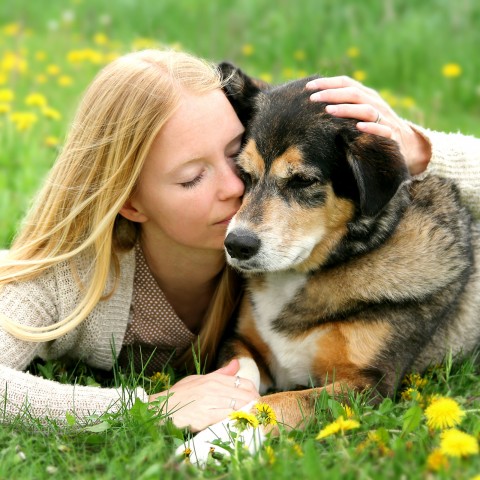
¿Quién es el mejor amigo del hombre? (“Who is man’s best friend?”)
 Table of Contents
Table of Contents
- Pets
- Farm Animals
- Wild Animals
- Sea Animals
- Bugs
- Birds, Reptiles & Amphibians
- Animal Body Parts
- Bonus: Animal Idioms and Proverbs
- Final Thoughts
1. Pets
The Spanish word for “pet” is mascota. Spanish mascotas are important in every household, as they’re considered to be uno más de la familia (“a member of the family”).
In Spain, as in most countries, dogs and cats are the preferred pets. Small mammals like rabbits and hamsters, or even small birds, are common children’s pets, as they’re easier to take care of. Exotic pets, such as snakes and other reptiles, have their fair share of fans; you can even see people walking their ferrets out in the street with a leash!
Here’s a list of popular pet animals in Spanish:
| El perro | “Dog” |
| El gato | “Cat” |
| In Spanish, there are no specific words for “puppy” or “kitten.” They’re often referred to as cachorro, a generic word for baby mammals. | |
| El hámster | “Hamster” |
| El ratón | “Mouse” |
| La rata | “Rat” |
| El conejo | “Rabbit” |
| La tortuga | “Turtle” |
| El pez | “Fish” |
| El periquito | “Parakeet” |
| Periquitos are one of the most popular pájaros (“birds”) in Spanish homes. | |
| La cobaya | “Guinea pig” |
| La serpiente | “Snake” |
| El hurón | “Ferret” |
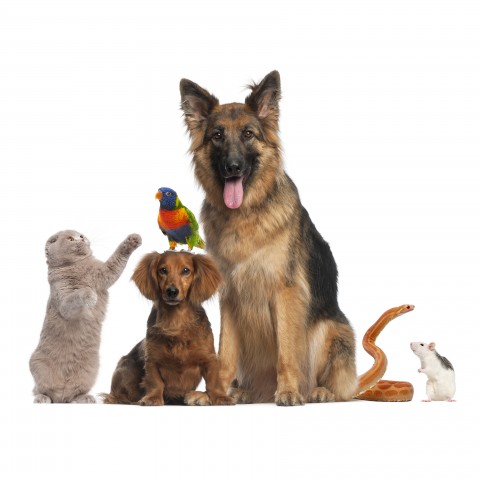
Las mascotas (“The pets”)
2. Farm Animals
It will be useful to learn the names of farm animals in Spanish, as the animals bred in Spain are more or less the same as those in the rest of the world. On a Spanish farm, you’ll find cows, pigs, and chickens. We included rabbits in the pet section, although some people in Spain eat them too!
Get ready for your trip to la granja (“the farm”)!
| La vaca | “Cow” |
| El toro | “Bull” |
| The toro is a well-known Spanish symbol. This is partly due to the bullfighting tradition of the country, but also because the popular brandy house Osborne placed 90 giant toro silhouettes all over Spain as part of a marketing campaign. This has become part of the popular Spanish imagery. | |
| La ternera | “Calf” |
| El cerdo | “Pig” |
| El burro | “Donkey” |
| When burro is used to describe a person, it’s an insult that implies the person is not very bright. | |
| El caballo | “Horse” |
| La mula | “Mule” |
| El pollo | “Chicken” |
| La gallina | “Hen” |
Gallina is often used as a colloquial way to call someone a coward, as in the English idiom “to chicken out.”
| |
| El gallo | “Rooster” |
| El pavo | “Turkey” |
| El pato | “Duck” |
| La oveja | “Sheep” |
| El carnero | “Male sheep” |
| El cordero | “Lamb” |
| La cabra | “Goat” |
- → Would you like to hear the pronunciation of these animal names? Then head over to SpanishPod101’s lesson on farm animals!
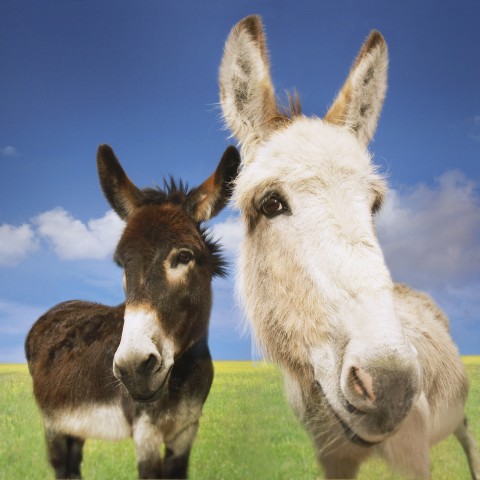
Un par de burros (“A pair of donkeys ”)
3. Wild Animals
It is said that, in Roman times, a squirrel could cross the entire Iberian Peninsula by jumping from one tree to another. Unfortunately, the Spanish flora has decreased greatly in the last few centuries—and so has its wild fauna.
However, it’s not uncommon to find wild foxes and boars in the Mediterranean mountains or wolves in the northern forests. If you’re very lucky, you might even encounter a lynx!
Here’s a list of animals in Spanish that you might find out in the wild, both in Spain and abroad:
| El tigre | “Tiger” |
| El león | “Lion” |
| El elefante | “Elephant” |
| La jirafa | “Giraffe” |
| El rinoceronte | “Rhino” |
| El hipopótamo | “Hippopotamus” |
| El mono | “Monkey” |
| Mono, like “monkey” in English, is a generic word we use to refer to all types of primates. The more specific monkey names are often similar to their English counterparts: gorila (“gorilla”), chimpancé (“chimpanzee”) and orangután (“orangutan”). | |
| El jabalí | “Boar” |
| El zorro | “Fox” |
| El oso | “Bear” |
| El ciervo | “Deer” |
| El reno | “Reindeer” |
| El lobo | “Wolf” |
| El lince | “Lynx” |
| One of the most popular native Spanish wild animals is the Iberian Lynx, a beautiful cat with a short tail and characteristic pointy beard and ears. Unfortunately, the Iberian Lynx is an endangered species and was on the verge of extinction 20 years ago. A successful reintroduction project has increased the number of cats from 94 to 855. | |
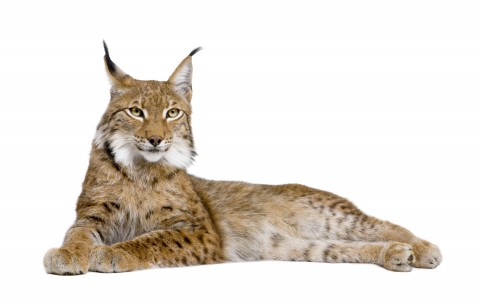
La mirada del lince (“The lynx’s gaze”)
4. Sea Animals
The Spanish territory has over 8000 kilometers (about 4971 miles) of coastline, which explains our strong cultural bond to the sea and its marine life. The Atlantic and Mediterranean coasts are home to a number of sea animals.
Here’s a list of animals in Spanish that you’ll find underwater:
| El tiburón | “Shark” |
| El delfín | “Dolphin” |
| La ballena | “Whale” |
| El pulpo | “Octopus” |
| El caballito de mar | “Seahorse” |
| El calamar | “Squid” |
| La foca | “Seal” |
| El cangrejo | “Crab” |
| La langosta | “Lobster” |
| La gamba | “Shrimp” |
| El mejillón | “Mussel” |
| La medusa | “Jellyfish” |
| In Spanish, jellyfish share a name with the mythological Greek creature that turned people into stone by looking into their eyes. On Spanish beaches, though, medusas are very much real and common. You don’t want to cross them, as their sting hurts a lot! | |
- → Want to dive deeper? Then visit our vocabulary list Marine Animals & Fish to learn even more words along with their pronunciation!
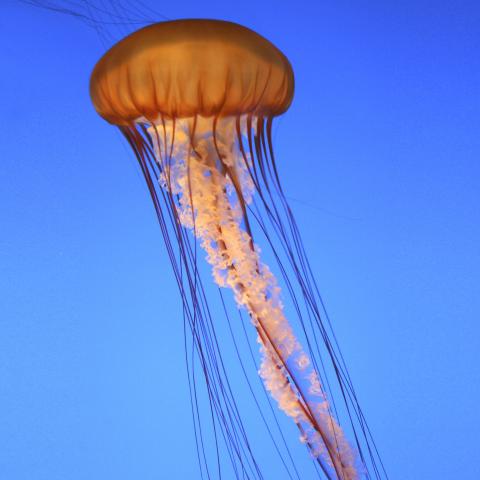
Cuidado con la medusa. (“Beware the jellyfish.”)
5. Bugs
¡Bichos! This is the Spanish word for bugs, used on occasions when you need to point out the unpleasant company of these little animals. But it’s also commonly used to describe a person who is a bit naughty, or even as an affectionate nickname in the diminutive form bichito.
- Él quiere mucho a su gato, le llama su “bichito.” – “He loves his cat very much; he calls her his bichito.”
If you visit Spain during the summer, you won’t have to worry too much about dangerous animals. However, take into account that flies and mosquitoes won’t leave you alone!
| La hormiga | “Ant” |
| La mosca | “Fly” |
| El mosquito | “Mosquito” |
| La araña | “Spider” |
| In Spanish, the spider web is called a telaraña. | |
| El grillo | “Cricket” |
| La abeja | “Bee” |
| La avispa | “Wasp” |
| La polilla | “Moth” |
| La mariquita | “Ladybug” |
| La mariposa | “Butterfly” |
| La lengua de las mariposas (“Butterfly Tongue”) is a 1999 movie by José Luis Cuerda, set in the region of Galicia during the Spanish Civil War. It explores the relationship between a pupil and his teacher. | |
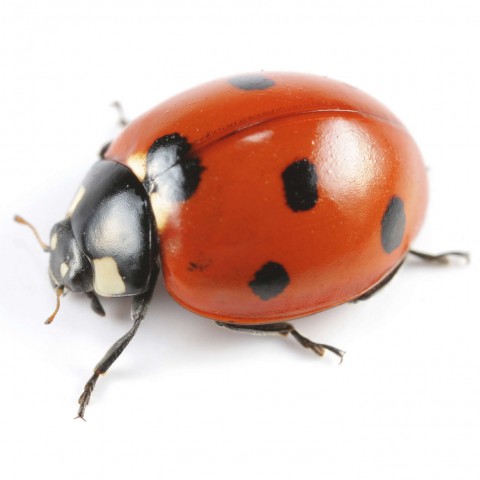
Una mariquita (“A ladybug”)
6. Birds, Reptiles & Amphibians
There are many species of wild birds, reptiles, and amphibians in Spain. Of course, you can find frogs croaking in the many Spanish water reservoirs and swallows flying over the countryside during springtime.
Fun fact: There is a breed of little green parrots, called cotorras, that are native to Argentina. They were introduced in Spain as exotic pets, and now that some of them have escaped, there is a sizable population of them in cities such as Barcelona.
| La paloma | “Pigeon” / “Dove” |
| Paloma can refer to both the city pigeon and the beautiful white dove. | |
| La gaviota | “Seagull” |
| El águila | “Eagle” |
| This word is a tricky one! Although most Spanish animal names (and nouns, for that matter) ending in “a” are gendered feminine, this one is masculine. | |
| El cuervo | “Crow” |
| El flamenco | “Flamingo” |
| The word flamenco can refer to both the traditional Spanish music genre and the pink bird. Depending on the time of year, this migratory bird resides in different wetlands of the Spanish territory, such as the Doñana National Park or the Ebro River Delta. | |
| El loro | “Parrot” |
| La golondrina | “Swallow” |
| La rana | “Frog” |
| El sapo | “Toad” |
| El lagarto | “Lizard” |
| La iguana | “Iguana” |
| El cocodrilo | “Crocodile” |
| Note that cocodrilo and “crocodile” are quite similar, but take into account that the position of the “r” is different! | |
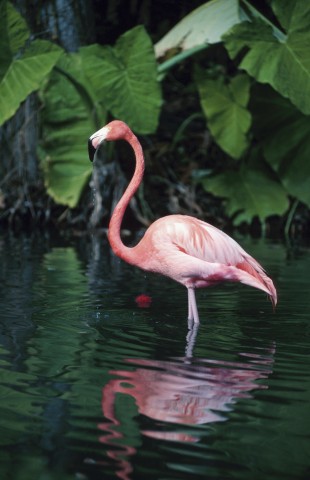
¿Los flamencos bailan flamenco? (“Do flamingos dance flamenco?”)
7. Animal Body Parts
Now that you know several different animal names in Spanish, it’s time to learn what to call their various body parts.
| Pata | “Paw” / “Leg” |
| Cola | “Tail” |
| Ala | “Wing” |
| Garra | “Claw” |
| Garra is the generic term for animal claws. In the case of felines, who have very special claws, theirs are called zarpas. | |
| Cuerno | “Horn” |
| Pluma | “Feather” |
| Pico | “Beak” / “Bill” |
| Hocico | “Snout” |
The colloquial version of hocico is morro. This word is also used to refer to human mouths in a slightly negative (but rather joking) way, especially in the plural form morros.
| |
| Caparazón | “Shell” |
| Aleta | “Fin” |
| Bigotes | “Whiskers” |
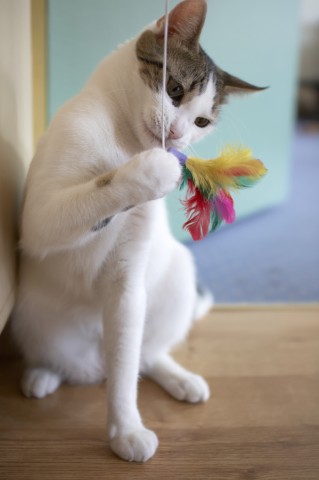
Los gatos tienen zarpas. (“Cats have claws.”)
8. Bonus: Animal Idioms and Proverbs
| Spanish expression | Sentir mariposas en el estómago |
| English equivalent | “To feel butterflies in one’s stomach” |
| This expression is often used to describe the nervous feeling of someone who is infatuated or in love. | |
| Spanish expression | Tener la piel de gallina |
| English equivalent | “To have goosebumps” |
| This refers to the nervous reaction of the skin to cold or to powerful emotions. | |
| Spanish expression | Como pez fuera del agua |
| English equivalent | “Like fish out of water” |
| It means that someone feels completely out of their comfort zone or out of place. | |
| Spanish expression | Ser la oveja negra |
| English equivalent | “To be the black sheep” |
This refers to a family member or another individual who does not fit in.
| |
| Spanish expression | Hay cuatro gatos. |
| This literally translates to, “There are four cats.” It’s used to describe a place that’s quite empty. | |
| Spanish expression | Perro ladrador, poco mordedor |
| English equivalent | “His bark is worse than his bite.” |
| This describes the type of person who seems very brave when they talk but rarely takes action. | |
| Spanish expression | A caballo regalado, no le mires el diente. |
| English equivalent | “Don’t look a gift horse in the mouth.” |
| This proverb means that one shouldn’t be too picky when gifted with something. | |
| Spanish expression | De noche, todos los gatos son pardos. |
| This phrase means, “At night, all cats are black.” It advises that when it’s dark (and especially after drinking a bit too much), we often overlook other people’s defects. | |
| Spanish expression | Aunque la mona se vista de seda, mona se queda. |
| English equivalent | “You can’t make a silk purse out of a sow’s ear.” |
| This Spanish proverb literally means: “Even when the monkey is dressed in silk, it’s still a monkey.” It means that when someone or something is ugly, there’s not much that can be done about it. | |
| Spanish expression | Gato con guantes no caza ratones. |
| English equivalent | “A cat with gloves catches no mice.” |
| This phrase warns that it’s better to be dressed for the job at hand rather than trying to be too fancy. | |
| Spanish expression | A perro viejo todo son pulgas. |
| English equivalent | “Old dogs have all the fleas.” |
| Usually, this expression is used in reference to all of the illnesses and various health-related problems that come with age. | |
9. Final Thoughts
In this article, we provided you with a list of animals in Spanish that will help you navigate situations involving anything from pets to nasty bugs!
What’s your favorite animal? Do you remember its name in Spanish?
At SpanishPod101.com, you can continue learning the Spanish language and exploring Spanish culture. There are plenty of free resources, such as vocabulary lists and our word of the day tool, as well as lessons tailored for every level of fluency.
Happy learning on SpanishPod101.com!










